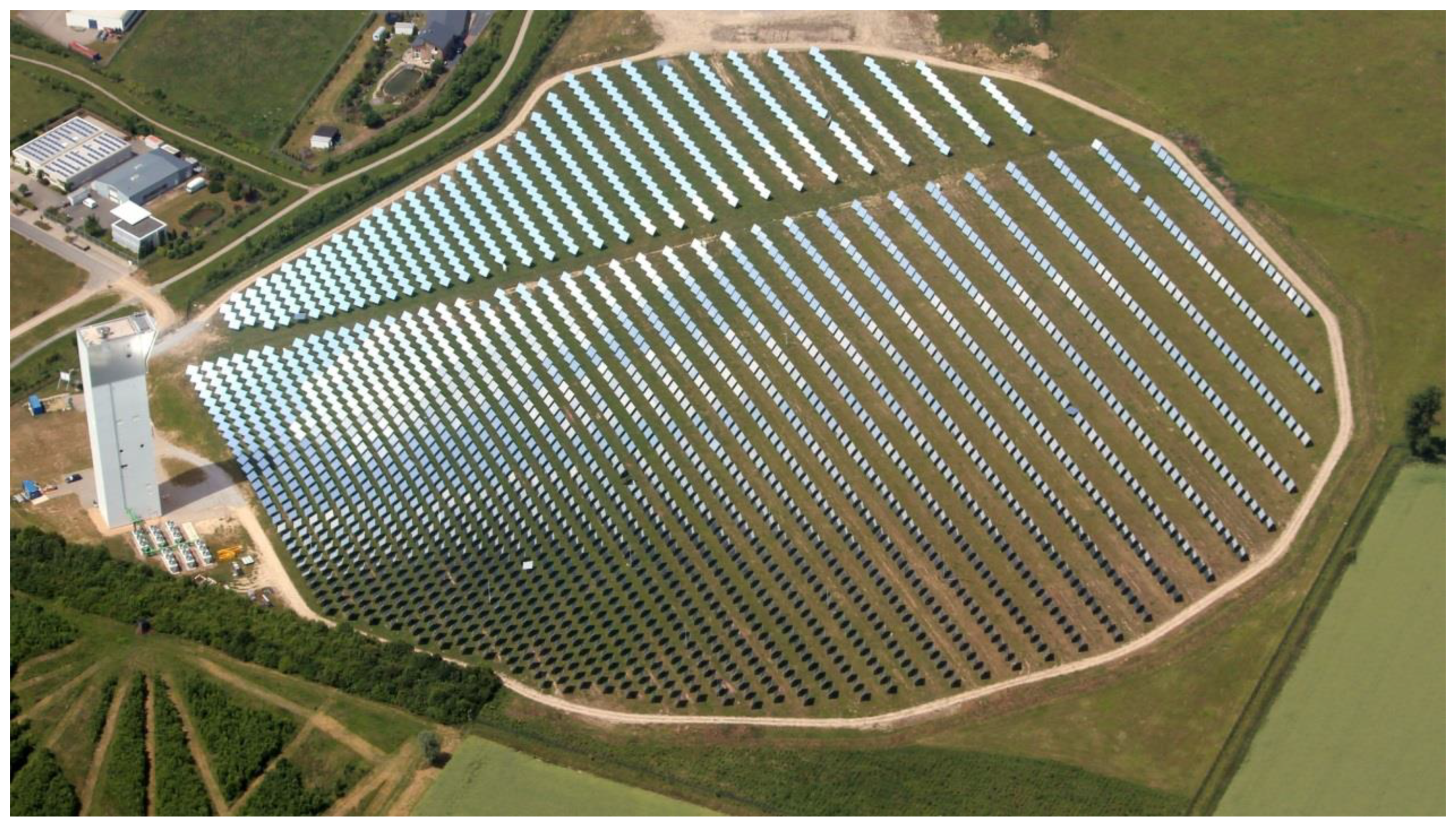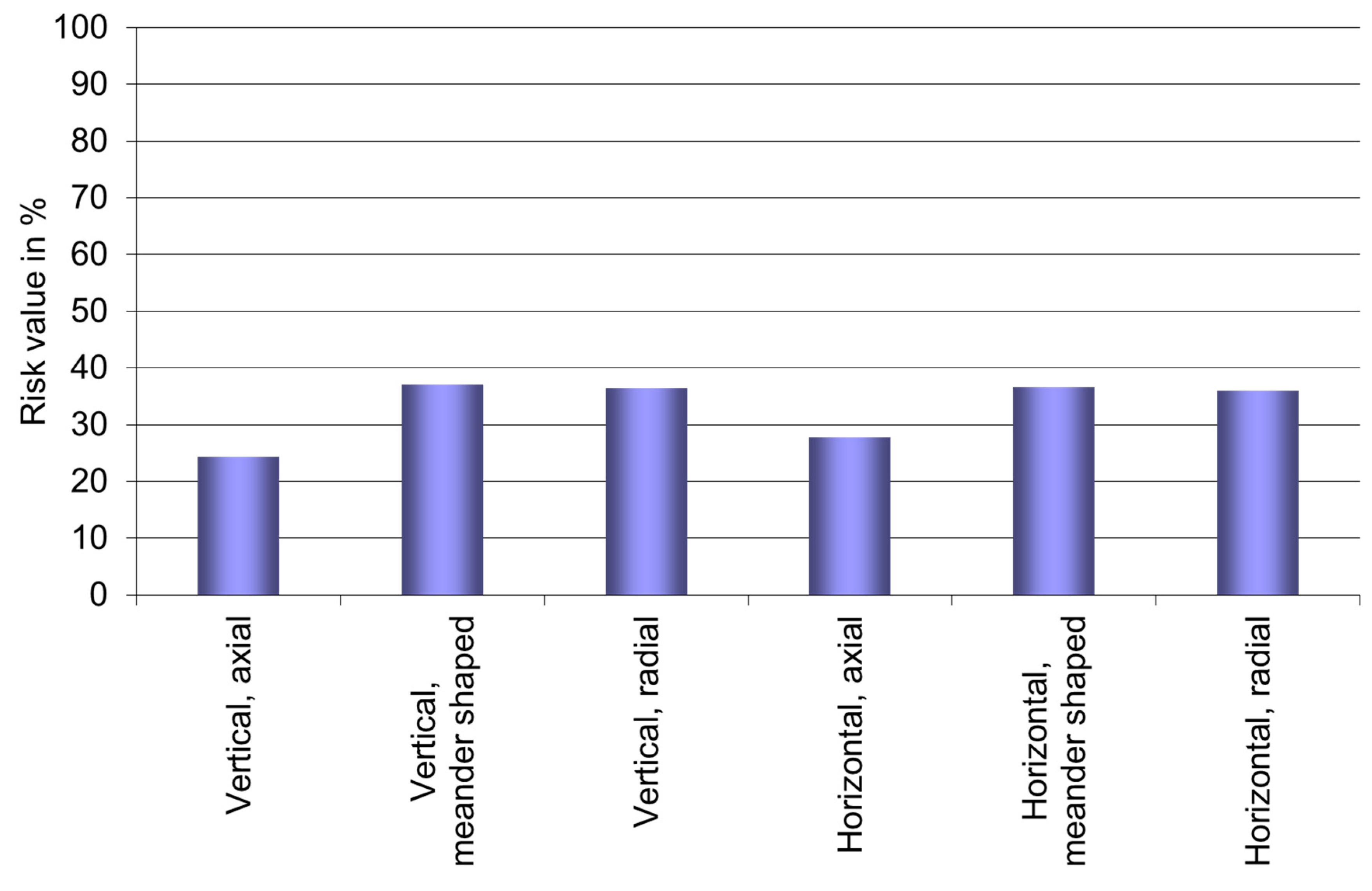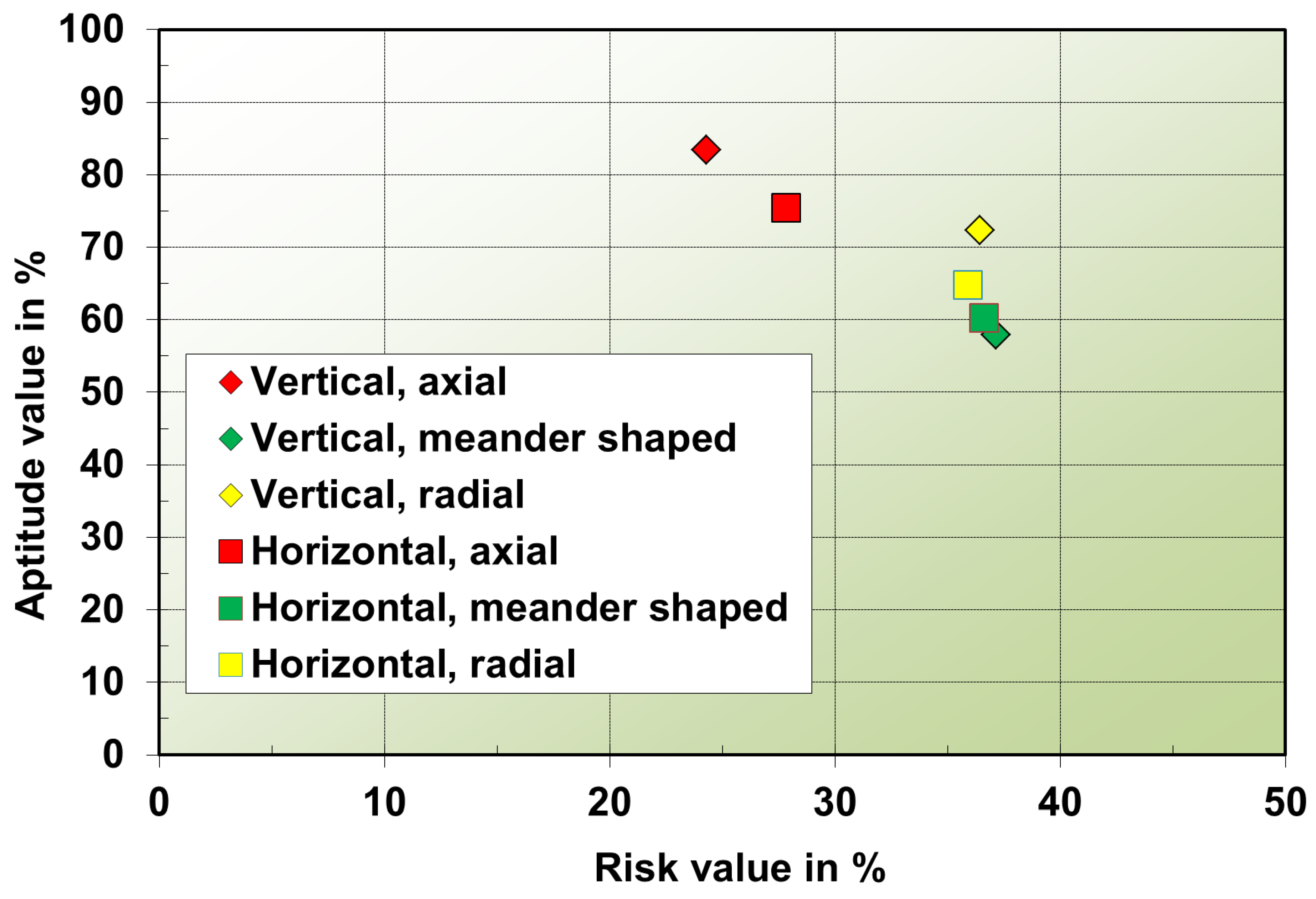Slag as an Inventory Material for Heat Storage in a Concentrated Solar Tower Power Plant: Design Studies and Systematic Comparative Assessment
Abstract
:Featured Application
Abstract
1. Introduction
2. State of the Art of TES in CSP Plants
3. Design of Slag-Based TES
3.1. CSP Plant Target Specifications
3.2. Considered TES Designs
3.3. Pre-Design of Storage
Dimensioning of TES
3.4. Comparative Assessment and Definition of a Lead Concept
Quality Function Deployment (QFD) and Failure Mode and Effect Analysis (FMEA)
4. Summary and Conclusions
Author Contributions
Funding
Conflicts of Interest
References
- Pitz-Paal, R. Solar Energy-Concentrating Solar Power. In Future Energy; Elsevier Science: New York, NY, USA, 2014; pp. 405–431. [Google Scholar]
- European Association for Storage of Energy (EASE); European Energy Research Alliance (EERA). European Energy Storage Technology Development Roadmap-2017 Update; EASE/EERA: Brussels, Belgium, 2017. [Google Scholar]
- Temporärer ProcessNet-Arbeitskreis Rohstoffe und Kreislaufwirtschaft. Anorganische Rohstoffe - Sicherung der Rohstoffbasis von Morgen; DECHEMA, e.V.: Frankfurt, Germany, 2015. [Google Scholar]
- Buchert, M. Press Release: Transition to Sustainable Raw Materials Management Needed in Germany; Oeko-Institut: Freiburg/Berlin, Germany, 2015. [Google Scholar]
- Öko-Institut, e.V. Rohstoffwende 2049: Zur Zukunft der Nationalen und Internationalen Rohstoffpolitik. Jahrestagung; Öko-Institut e.V.: Freiburg, Germany, 2016. [Google Scholar]
- Federal Ministry for the Environment, Nature Conservation and Nuclear Safety. German Resource Efficiency Programme II-Programme for the Sustainable Use and Conservation of Natural Resources; Federal Ministry for the Environment, Nature Conservation and Nuclear Safety: Berlin, Germany, 2016. [Google Scholar]
- European Commission. Communication from the Commission to the European Parliament, the Council, the European Economic and Social Committee and the Committee of the Regions: Roadmap to a Resource Efficient Europe; European Commission: Brussels, Belgium, 2011. [Google Scholar]
- Zunft, S.; Hänel, M.; Krüger, M.; Dreißigacker, V.; Göhring, F.; Wahl, E. Jülich Solar Power Tower-Experimental Evaluation of the Storage Subsystem and Performance Calculation. J. Sol. Energy Eng. 2011, 133, 1019–1023. [Google Scholar] [CrossRef]
- Zunft, S.; Hänel, M.; Krüger, M.; Dreißigacker, V. A design study for regenerator-type heat storage in solar tower plants-Results and conclusions of the HOTSPOT project. Energy Procedia 2014, 49, 1088–1096. [Google Scholar] [CrossRef]
- Laing, D.; Zunft, S. Using concrete and other solid storage media in thermal energy storage (TES) systems. In Advances in Thermal Energy Storage Systems: Methods and Applications; Woodhead Publishing: Cambridge, UK, 2015; pp. 65–86. [Google Scholar]
- Stahl, K.; Moser, P.; Marquardt, R.; Siebert, M.; Kesser, S.; Maier, F.; Krüger, M.; Zunft, S.; Dreißigacker, V.; Hahn, J. Flexibilisierung von Gas- und Dampfturbinenkraftwerken durch den Einsatz von Hochtemperatur-Wärmespeichern (FleGs): F&E Vorhaben zur Vorbereitung von Hochtemperatur-Wärmespeichern und Deren Integration in den Gas- und Dampfturbinenprozess; RWE Power AG: Essen, Germany, 2013. [Google Scholar]
- Stahl, K.; Zunft, S.; Kessler, S.; Siebert, M. Flexibilisierung von GuD-Kraftwerken durch den Einsatz von Hochtemperatur-Wärmespeichern. In VDI-Konferenz “GuD-Kraftwerke im Dynamischen Netzbetrieb”, 29–30 November, Köln Germany; Verein Deutscher Ingenieure (VDI): Düsseldorf, Germany, 2011. [Google Scholar]
- Zunft, S.; Freund, S. Large-scale Electricity Storage with Adiabatic CAES-the ADELE-ING project. In Proceedings of the Energy Storage Global Conference, Paris, France, 19–21 November; Energy Storage Association: New York, NY, USA, 2014. [Google Scholar]
- Zunft, S. ADELE-ING: Engineering-Vorhaben für die Errichtung der Ersten Demonstrationsanlage zur adiabaten Druckluftspeichertechnik; German Aerospace Center: Stuttgart, Germany, 2017. [Google Scholar]
- Krüger, M.; Haunstetter, J.; Zunft, S. Concentrated solar tower power plant using slag as inventory material for a thermal energy storage (TES). In AIP Conference Proceedings; AIP Publishing: Melville, NY, USA, 2018; Volume 2033, pp. 090018-1–090018-8. [Google Scholar]
- RESLAG. Available online: http://www.reslag.eu (accessed on 18 February 2019).
- Grosu, Y.; Ortega-Fernández, I.; del Amo, J.M.L.; Faik, A. Natural and by-product materials for thermocline-based thermal energy storage system at CSP plant: Compatibility with mineral oil and molten nitrate salt. Appl. Therm. Eng. 2018, 136, 657–665. [Google Scholar] [CrossRef]
- Dreißigacker, V.; Müller-Steinhagen, H.; Zunft, S. Thermo-mechanical analysis of packed beds for large-scale storage of high temperature heat. Heat Mass Transf. 2010, 46, 1199–1207. [Google Scholar] [CrossRef]
- Ortega-Fernández, I.; Calvet, N.; Gil, A.; Rodríguez-Aseguinolaza, J.; Faik, A.; D’Aguanno, B. Thermophysical characterization of a by-product from the steel industry to be used as a sustainable and low-cost thermal energy storage material. Energy 2015, 89, 601–609. [Google Scholar] [CrossRef]
- Akao, Y. Quality Function Deployment: Integrating Customer Requirements into Product Design; Productivity Press: Cambridge, UK, 1990. [Google Scholar]
- Akao, Y.; Mizuno, S. QFD: The Customer-Driven Approach to Quality Planning and Deployment; Asian Productivity Organisation: Tokyo, Japan, 1994. [Google Scholar]








| Description | Characterization | Comments |
|---|---|---|
| Rated net power output of CSP plant | 150 MWel | |
| TES capacity | 6.5 h (2.21 GWh) | Considering the solar multiple factor and charging duration. |
| Temperature at TES inlet while charging | 700 °C | |
| Temperature at TES inlet while discharging | 120 °C | |
| Max. temperature drop at TES outlet while discharging | 60 °C | |
| Max. pressure loss through the TES while discharging | 100 mbar | |
| Discharging mass flow | 780 kg/s | At design point (12 p.m., 21 March) |
| Max. charging mass flow through TES | 1080 kg/s | At design point (12 p.m., 21 March) |
| Mean charging mass flow through TES | 706 kg/s | On design day (21 March) |
| Charging duration | 8 h | Assumption: sinusoidal course of the sun Considering the solar multiple factor and sunshine hours |
| Hours of sunshine on design day (21 March) | 12.2 h | Location: Huelva (Spain) |
| Solar multiple | 2 | At design point (12 p.m., 21 March) |
| TES Option | Advantage | Disadvantage |
|---|---|---|
| Vertical TES |
|
|
| Horizontal TES |
|
|
| Axial flow |
|
|
| Radial flow |
|
|
| Meander-shaped flow |
|
|
| Description | Characterization | Comments |
|---|---|---|
| Density | 3430 kg/m3 | |
| Thermal conductivity | 1.43 W/(m K) | at 500 °C |
| Specific heat capacity | 0.933 kJ/(kg K) | at 500 °C |
| Group | Criterion | Description | Weighting Factor |
|---|---|---|---|
| Economical demand | Low investment costs | Will be calculated in a simplified way; includes inventory, containment and liner (protects insulation) costs. Simple designs without internals for flow guidance and distribution have advantages here. | 7.1 |
| Low operating costs | Will be calculated in a simplified and qualitative way; includes, e.g., auxiliary power for ventilation, costs for inventory change etc. | 5.9 | |
| High storage degree of utilization | Is calculated by thermal simulation; indicates the utilization of the inventory, that means how much of the inventory undergoes the full temperature increase. | 0.6 | |
| Low space need | Base area of container is considered as well as the needed container number. | 1.8 | |
| High operational availability | Is reduced, for example, by out of order or maintenance times of the TES. Possible bypass flows due to settlement effects and hazards to thermal insulation at hot points due to high loads are taken into account. | 10.0 | |
| Long lifetime | Of the TES and its subcomponents. The higher the inventory level, the higher the forces on inventory, insulation and container. The lower the inventory level, the more gentle on the materials and the higher the potential lifetime. | 10.0 | |
| Technical demand | Low expense of protection for insulation | The basis is an inner liner which is used from a storage height of 10 m. | 4.1 |
| High storage degree of uniformity | Ratio of effective emitted energy over discharge duration to maximal possible energy withdrawal over discharge duration. | 9.0 | |
| Low complexity | Of the construction and connection. | 7.2 | |
| High degree of maturity | Commercial availability of components. Concepts already available on the market must be evaluated as better than those for which only test setups or even only drawings exist. | 10.0 | |
| Good scalability | To larger or smaller storage | 8.7 | |
| Low expense of system integration | Of the TES. | 6.7 | |
| Low expense of fluid distribution | Good and even fluid distribution. | 3.8 | |
| Low expense of insulation | Inner and outer insulation of the TES. | 3.6 | |
| Low expense of filling | Filling the TES with slag pebbles. | 2.1 | |
| Low maintenance effort | Level of access. In particular, good accessibility at all points is crucial here. | 6.7 | |
| Low cleaning effort of working fluid | Filter mandatory? Cleaning amount of filter. | 4.6 | |
| Low safety effort | Safety must be ensured but at what expense? | 1.3 |
| Criteria | Description | Damage Factor * |
|---|---|---|
| Thermal design uncertainties | Uncertainties in material parameters, model uncertainties | 5 |
| Thermomechanical design uncertainties | Uncertainties in material parameters, model uncertainties | 3 |
| Fluid mechanical design uncertainties | Model uncertainties | 5 |
| Material failure | Inventory, insulation | 4 |
| Corrosion | Inventory, insulation, container, piping (everything that is in contact with the high temperature fluid (HTF)) | 7 |
| Operating restrictions due to the complexity of the storage system | Piping, amount of container, storage installations, isolation equipment | 4 |
| Operational safety | Outer damages which can influence the operational safety, e.g., fluid leaking | 9 |
| Economic uncertainties | False estimation of investment and operational costs | 2 |
| Lack of competition for plant components | Low amount of providers or no provider for essential components | 3 |
© 2019 by the authors. Licensee MDPI, Basel, Switzerland. This article is an open access article distributed under the terms and conditions of the Creative Commons Attribution (CC BY) license (http://creativecommons.org/licenses/by/4.0/).
Share and Cite
Krüger, M.; Haunstetter, J.; Knödler, P.; Zunft, S. Slag as an Inventory Material for Heat Storage in a Concentrated Solar Tower Power Plant: Design Studies and Systematic Comparative Assessment. Appl. Sci. 2019, 9, 1833. https://doi.org/10.3390/app9091833
Krüger M, Haunstetter J, Knödler P, Zunft S. Slag as an Inventory Material for Heat Storage in a Concentrated Solar Tower Power Plant: Design Studies and Systematic Comparative Assessment. Applied Sciences. 2019; 9(9):1833. https://doi.org/10.3390/app9091833
Chicago/Turabian StyleKrüger, Michael, Jürgen Haunstetter, Philipp Knödler, and Stefan Zunft. 2019. "Slag as an Inventory Material for Heat Storage in a Concentrated Solar Tower Power Plant: Design Studies and Systematic Comparative Assessment" Applied Sciences 9, no. 9: 1833. https://doi.org/10.3390/app9091833





